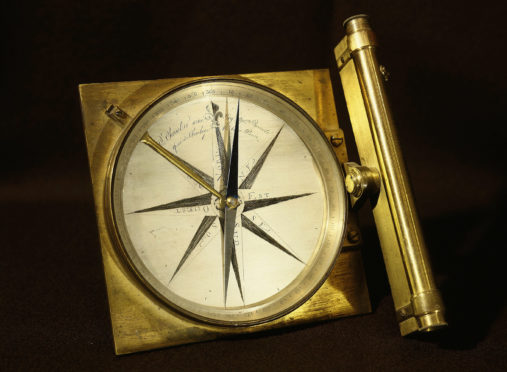I’ve always been fascinated by the compass.
North, East, South, West: such an apparently simple way of placing yourself in the world.
Though there are further co-ordinates within those four cardinal points, which I can still recite from memory (in both Gaelic and English): Tuath, Tuath ’n Ear, An Eara-Thuath, Nor-Nor-East, Nor-East and so on. You always of course travelled clockwise – deiseal in Gaelic – so as to be in tune with the (super)natural path of the sun.
Growing up as a child in South Uist, directions were easy to fathom: East was where the sun rose from behind the hills, South was Barra, West where the machair was, and North was where the great city of Daliburgh, with its travelling cinema and dances in the church hall, lay. Further North was the dangerous land marked ‘Here There Be Dragons’, officially known as Lewis!
People were (and still are) buried facing East, so that they would face their creator at the Resurrection. You never left your west-window open overnight, because that’s the direction the fairies came from to steal the goodness. West was where you eventually sailed to, towards America or, in the romances of the 19th century, towards Tir nan Òg. From the North came the freezing wind straight across the treeless moors all the way from the Arctic.
The strongest wind came from the north-west. A Lewis friend of mine tells me her mother, who had very little English, used to listen to the Shipping Forecast and would shiver when she heard the last word in this often-heard litany: ‘Rockall, Malin, Hebrides, Force Ten, Imminent.’ It was that word imminent that concerned her – “I don’t know what it means,” she’d say (in Gaelic) “but I don’t like the sound of it!”
When I moved to the mainland, to Oban, I had to re-orientate myself. Inverness was awkward for I didn’t know whether it was north or east. It was a bit like Perth, sort of in the middle. The east for me for some cultural reason (perhaps to do with the tragedy of Culloden) started at Nairn. In global terms of course we have the North Atlantic and the South Pacific and the East Indies and the Far East and the Middle East and the Deep South and the Far North and the Wild West. No wonder I always regretted that there was no East Uist or West Uist to make a perfect globe of the already existing Uists.
The quartering of things is as old as humankind itself: north, east, south, west; morning, afternoon, evening, night; spring, summer, autumn, winter; ploughing, planting, harrowing, harvesting; earth, wind, fire and air. It gives us rhythm and co-ordinates, and because of our long human evolution any disturbance to those elemental markers upsets the balance.
Many of us now live in a world removed from these elements. We don’t really need to know where north or south or east or west is because GPS tells us where to go. Why concern ourselves with the seasons since we can just pop down any time to the supermarket to buy strawberries in December and ice in July? A constant 24 hour news cycle on our iplayers means that we can watch whatever we want whenever we want: the distinction between night and day has been eroded. It’s strange to think now that there was a time when TV closed down around 11pm (an hour after the pubs) with “the word of God and prayer at the close of day”. Then it was either bed or the test card.
The sea was of course the motorway of the times, which in itself alters our geographic orientation. The sea kingdom of the Lords of the Isles (Rìoghachd nan Eilean) stretched over 300 miles from the Butt of Lewis in the north to the southern tip of the Isle of Man, with the sea routes connecting everything from Barra to Bergen and beyond.
My father-in-law, now aged 88, was a merchant navy skipper and for years ran the trade and passenger ferry between Leith and Copenhagen. Taking coal to Denmark and returning with bacon and butter back across the North Sea. He also traded regularly with West Africa, carrying cars and colonial officials and missionaries out there and balsam wood and palm oil (even in those days) back to Leith.
The only qualification when asking an Uibheastach for directions however has to so with up and down. We are so used to seeing north as being at the top of a map and south at the bottom that we naturally assume you go up north and down south. But not in South Uist – you go up south and down north. It helps you to challenge assumptions and preconceptions.
Just like that word ‘remote’, which is often used to describe islands and various rural communities. London is as remote to the Uibhisteach as Uist is to the Londoner, or as The Fool said to The King when His Highness asked him where the centre of the earth was ‘Why, Sir, right here. Beneath my feet. And yours, your Majesty.’
Angus Peter Campbell is an award-winning writer and actor from Uist
